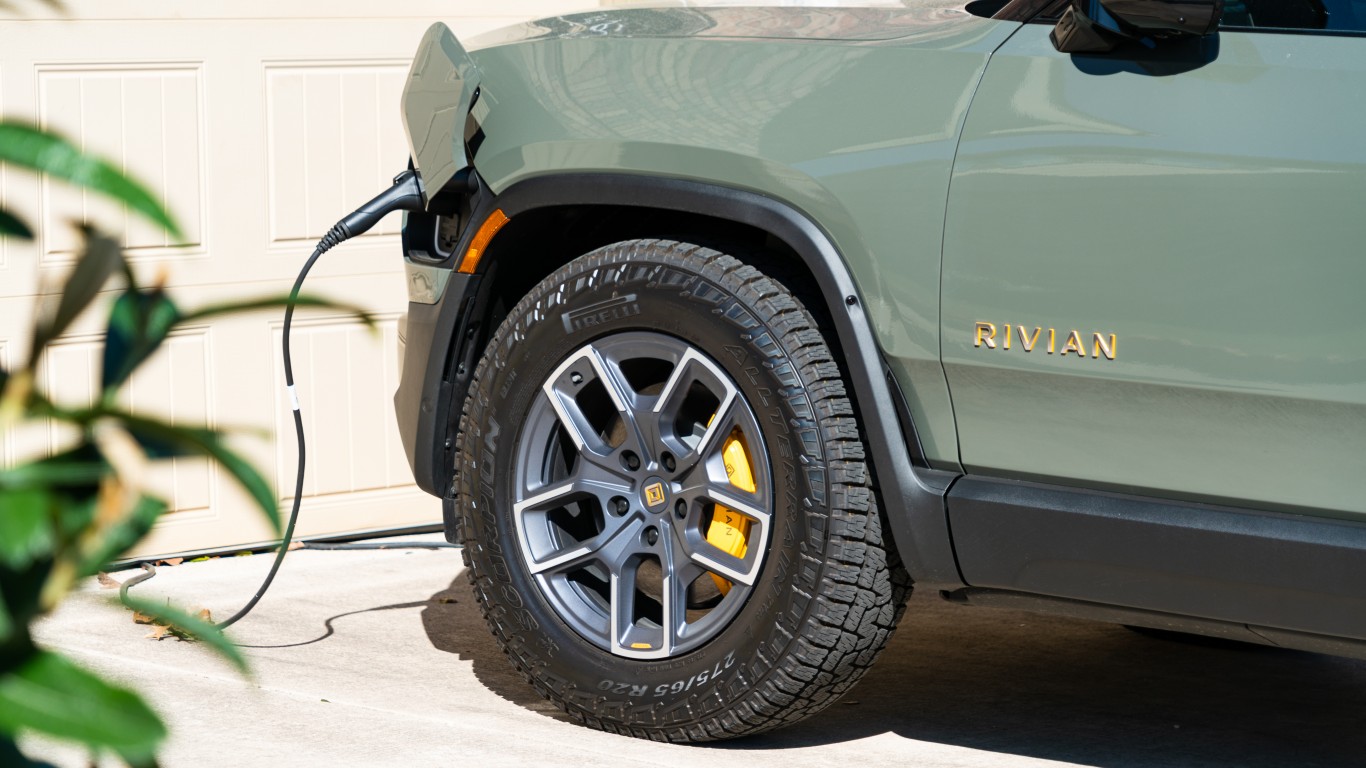

On Tuesday, Rivian (RIVN) announced a milestone agreement with Tesla (TSLA) to incorporate North American Charging Standard (NACS), previously known as the Tesla charging connector.
Rivian is known for its robust utility vehicles, R1T and R1S, with around 400 miles range. By next spring, these cars will be able to access Tesla’s existing 12,000-strong Supercharger network across the US and Canada. Although Rivian is smaller than Chinese BYD and Tesla, the EV company has ambitious growth targets.
After an upgrade, its main plant in Normal, Illinois, is projected to churn out 200,000 EVs, while the new $5B plant in Georgia is expected to double the figure to 400,000 EVs starting in 2024. By joining the NACS standard, Rivian follows legacy automakers Ford and General Motors, which will also incorporate the Tesla-born standard for future EVs. Tesla shares saw decent gains on the news, up 3.3% for the day at time of writing.
NACS: Tesla’s EV Industry Standard
In the pioneering years of electric vehicles (EVs), sparse and inefficient charging stations were one of the main adoption obstacles. A study from Berkeley University covering California’s Bay Area concluded that only 72.5% of EV charging stations were functional out of 657 EVSEs (electric vehicle service equipment).
If California, a leader in EV adoption, has such reliability issues, it bodes ill for the rest of the country. As the trailblazing EV producer, Tesla began to change the infrastructure landscape by introducing the Tesla charging connector in 2012 as the proprietary charging standard.
From then to 2021, Tesla Superchargers’ market share grew to 60% of all EV charging stations in the US. Previously, the dominant standard was the Combined Charging System (CSS), promoted by the Charging Interface Initiative (CharIN) association.
Before CSS dominance, having combined AC and DC inlet ports, the Japanese CHAdeMO plug was common, owing to the popularity of very early EVs, such as the Nissan LEAF. Following the ‘rising tide lifts all boats’ philosophy, in November 2022, Tesla finally opened the standard for other EV manufacturers, having renamed it to North American Charging Standard – NACS.
This March, Tesla began rolling out its CCS-compatible charging stalls that include ‘Magic Dock’ connectors. Although sparse, these allow even non-Tesla EVs to fill their batteries.
What’s So Special about NACS?
For any industry standard to enjoy wide adoption, it has to meet certain requirements. Tesla’s NACS accomplishes this by including several key features:
- Compact design without any moving parts.
- Twice as powerful as Combined Charging System (CSS) connectors, at an upper DC charging range of 1MW, alongside AC charging.
- It is agnostic to the manufacturer’s communication protocol and use case, making it easy to integrate.
Tesla still deploys CCS Type 2 connectors alongside DC Type 2 connectors for the EU market.
Thanks to its cheaper pricing, Chinese BYD, Tesla’s largest global EV competitor, uses a Combined Charging System (CCS). For BYD Atto 3 model that uses Euro-standard Type 2 CSS, the charging rate is up to 80kW.
In contrast, Tesla’s NACS can handle up to 250 kilowatts of DC fast-charging. This was after the Tesla Supercharger V3 upgrade. However, CSS standard is not standing still, as the latest upgrade design features up to 350kW charge rate or up to 800kW if upgraded to liquid-cooled cables.
Nonetheless, the higher the charging range, the more expensive it is to implement superchargers as an EV infrastructure. This results in diminishing returns. After all, level 3 chargers, which presently offer up to 350kW charge rate, are over 10x more expensive than level 1 home chargers.
Likewise, with that capacity, EVs would belong in the upper end of the luxury EV category. Established super-charging dominance leaves Tesla’s NACS in a favorable position as the golden middle ground.
Rivian and Tesla Investor Reception
As Rivian’s NACS adoption hit the public spotlight, RIVN stock jumped +6.7%, outperforming TSLA over the week. Over the day, Tesla jumped +3.3%, outpacing the good news earlier in the month when all Tesla Model 3 cars became eligible for $7.500 EV tax credits.
However, Tesla still retains its hybrid tech-growth/blue-chip status. Year-to-date, TSLA is up +148% while RIVN is down -10%.
Regardless of NACS integration, Rivian will still grow its existing Rivian Adventure Network (RAN), although likely at a decelerated pace. By next year, RAN should cover 600 locations with 3,500 charging stations.
In the meantime, we will likely see more NACS adoptees after Ford, General Motors, and Rivian. European companies, such as Volkswagen, are still heavily reliant on CCS as they try to popularize the standard on the global level.
For this reason, Volkswagen Group invested in the Electrify America network, which promotes CCS. Hyundai Motor Group belongs under the same CSS umbrella, alongside China as the world’s largest EV market.
Therefore, it is incumbent on European manufacturers if they will make NACS the de-facto global charging standard in the next few years.
This article originally appeared on The Tokenist
Take This Retirement Quiz To Get Matched With An Advisor Now (Sponsored)
Are you ready for retirement? Planning for retirement can be overwhelming, that’s why it could be a good idea to speak to a fiduciary financial advisor about your goals today.
Start by taking this retirement quiz right here from SmartAsset that will match you with up to 3 financial advisors that serve your area and beyond in 5 minutes. Smart Asset is now matching over 50,000 people a month.
Click here now to get started.
Thank you for reading! Have some feedback for us?
Contact the 24/7 Wall St. editorial team.



